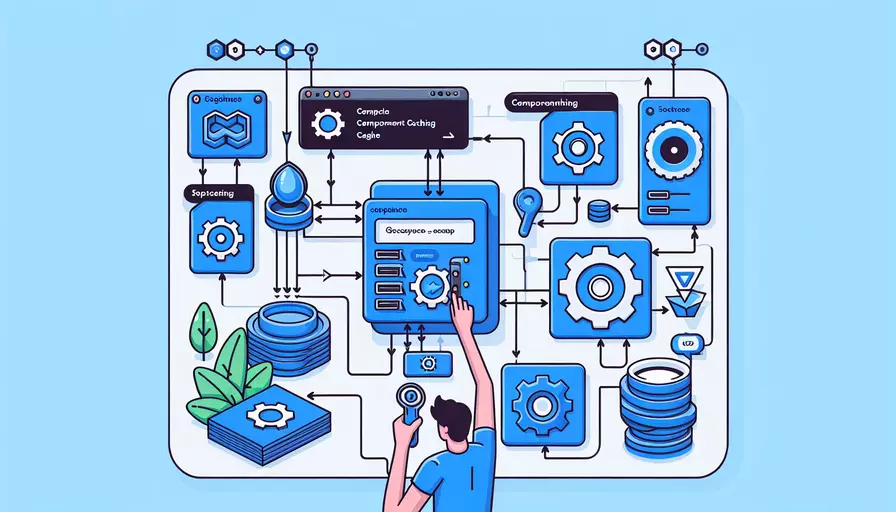
在Vue中实现缓存组件的主要方法有1、使用<keep-alive>组件,2、手动管理缓存状态和3、结合Vuex进行缓存管理。 下面将详细介绍这些方法,并提供具体步骤和示例代码。
一、使用``组件
Vue提供了一个内置的<keep-alive>组件,可以用于缓存动态组件。<keep-alive>主要用于包裹动态组件,从而在组件切换过程中保留其状态或避免重新渲染。
步骤:
- 定义动态组件: 你需要在父组件中定义一个动态组件。
- 使用
<keep-alive>包裹动态组件: 将动态组件用<keep-alive>包裹起来。
示例代码:
<template>
<div>
<button @click="currentView = 'ComponentA'">Show Component A</button>
<button @click="currentView = 'ComponentB'">Show Component B</button>
<keep-alive>
<component :is="currentView"></component>
</keep-alive>
</div>
</template>
<script>
import ComponentA from './ComponentA.vue';
import ComponentB from './ComponentB.vue';
export default {
data() {
return {
currentView: 'ComponentA'
}
},
components: {
ComponentA,
ComponentB
}
}
</script>
解释:
currentView是一个绑定到当前显示组件的动态绑定属性。<keep-alive>包裹着<component :is="currentView">,这样在切换currentView时,之前加载的组件将被缓存,不会被销毁。
二、手动管理缓存状态
在某些情况下,你可能需要更灵活的缓存机制。你可以手动管理组件的显示和隐藏来实现缓存。
步骤:
- 使用
v-if和v-show指令:v-if会销毁和重建元素,而v-show只是简单地切换元素的显示状态。 - 结合状态管理进行缓存: 使用Vue的状态管理(如Vuex)来管理组件的缓存状态。
示例代码:
<template>
<div>
<button @click="showComponentA = true">Show Component A</button>
<button @click="showComponentA = false">Show Component B</button>
<component-a v-show="showComponentA"></component-a>
<component-b v-show="!showComponentA"></component-b>
</div>
</template>
<script>
import ComponentA from './ComponentA.vue';
import ComponentB from './ComponentB.vue';
export default {
data() {
return {
showComponentA: true
}
},
components: {
ComponentA,
ComponentB
}
}
</script>
解释:
v-show指令会根据showComponentA的值来显示或隐藏ComponentA和ComponentB。- 与
v-if不同,v-show不会销毁组件,因此组件的状态会被保留,从而实现缓存。
三、结合Vuex进行缓存管理
当你的应用需要更复杂的状态管理时,可以结合Vuex来实现组件的缓存。Vuex是一个专为Vue.js应用设计的状态管理模式。
步骤:
- 安装并配置Vuex: 安装Vuex并在项目中进行配置。
- 定义缓存状态: 在Vuex中定义组件缓存状态。
- 根据状态显示组件: 在组件中根据Vuex的状态来决定组件的显示与隐藏。
示例代码:
// store.js
import Vue from 'vue';
import Vuex from 'vuex';
Vue.use(Vuex);
export default new Vuex.Store({
state: {
showComponentA: true
},
mutations: {
toggleComponent(state) {
state.showComponentA = !state.showComponentA;
}
}
});
<template>
<div>
<button @click="toggleComponent">Toggle Component</button>
<component-a v-show="showComponentA"></component-a>
<component-b v-show="!showComponentA"></component-b>
</div>
</template>
<script>
import { mapState, mapMutations } from 'vuex';
import ComponentA from './ComponentA.vue';
import ComponentB from './ComponentB.vue';
export default {
computed: {
...mapState(['showComponentA'])
},
methods: {
...mapMutations(['toggleComponent'])
},
components: {
ComponentA,
ComponentB
}
}
</script>
解释:
- 在Vuex的
state中定义了showComponentA来管理组件的显示状态。 - 通过
mapState和mapMutations将Vuex的状态和方法映射到组件中。 - 使用
v-show指令根据showComponentA的值来控制组件的显示与隐藏。
总结
通过上述三种方法,你可以在Vue中实现组件的缓存管理:
- 使用
<keep-alive>组件: 适用于简单的动态组件缓存。 - 手动管理缓存状态: 适用于需要更灵活的组件显示与隐藏控制。
- 结合Vuex进行缓存管理: 适用于复杂的应用状态管理和缓存需求。
这些方法可以根据实际需求进行选择和组合使用,以达到最佳的缓存效果和用户体验。建议在实际开发中根据具体情况选择合适的方法,并进行必要的优化和调整,以提高应用的性能和可维护性。
相关问答FAQs:
1. 什么是Vue的组件缓存?
Vue的组件缓存是指在使用Vue框架开发应用时,可以将某些组件缓存起来,以便在需要时快速加载和显示。通过缓存组件,可以提高应用的性能和用户体验。
2. 如何实现Vue的组件缓存?
Vue提供了一个内置的组件缓存机制,可以通过以下步骤来实现组件缓存:
步骤一:定义需要缓存的组件
首先,在Vue的组件中,可以使用<keep-alive>标签将需要缓存的组件包裹起来,例如:
<template>
<div>
<keep-alive>
<component :is="currentComponent"></component>
</keep-alive>
</div>
</template>
在上述代码中,<component>标签是一个动态组件,根据currentComponent的值来渲染不同的组件。
步骤二:切换组件
在需要切换组件时,只需要改变currentComponent的值即可。例如,可以通过按钮点击事件来切换组件:
<button @click="changeComponent">切换组件</button>
然后在Vue实例中定义changeComponent方法:
methods: {
changeComponent() {
this.currentComponent = 'OtherComponent';
}
}
这样,当点击按钮时,currentComponent的值将变为'OtherComponent',从而切换到另一个组件。
3. 如何设置组件缓存的过期时间?
Vue的组件缓存默认是永久性的,即一旦缓存,组件将一直保留在内存中。如果需要设置组件缓存的过期时间,可以使用include和exclude属性来指定需要缓存的组件和不需要缓存的组件。
例如,可以在<keep-alive>标签中使用include属性来指定需要缓存的组件:
<keep-alive :include="['ComponentA', 'ComponentB']">
<component :is="currentComponent"></component>
</keep-alive>
在上述代码中,只有ComponentA和ComponentB组件会被缓存,其他组件不会被缓存。
另外,还可以使用exclude属性来指定不需要缓存的组件:
<keep-alive :exclude="['ComponentC', 'ComponentD']">
<component :is="currentComponent"></component>
</keep-alive>
在上述代码中,除了ComponentC和ComponentD组件,其他组件都会被缓存。
通过使用include和exclude属性,可以灵活地控制组件缓存的过期时间,提高应用的性能和用户体验。
文章标题:vue如何实现缓存组件,发布者:不及物动词,转载请注明出处:https://worktile.com/kb/p/3624990

 微信扫一扫
微信扫一扫  支付宝扫一扫
支付宝扫一扫 